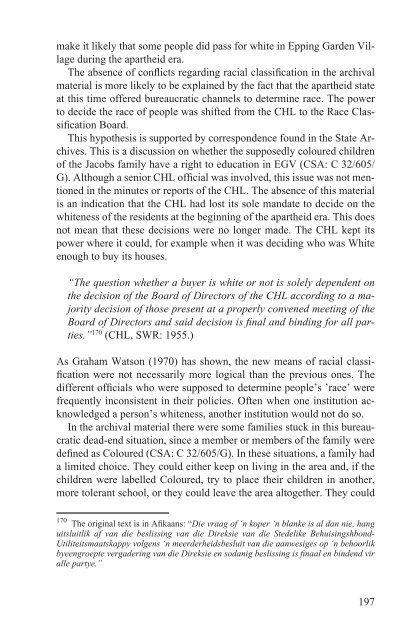The Making of a Good White - E-thesis - Helsinki.fi
The Making of a Good White - E-thesis - Helsinki.fi
The Making of a Good White - E-thesis - Helsinki.fi
You also want an ePaper? Increase the reach of your titles
YUMPU automatically turns print PDFs into web optimized ePapers that Google loves.
make it likely that some people did pass for white in Epping Garden Village<br />
during the apartheid era.<br />
<strong>The</strong> absence <strong>of</strong> conflicts regarding racial classi<strong>fi</strong>cation in the archival<br />
material is more likely to be explained by the fact that the apartheid state<br />
at this time <strong>of</strong>fered bureaucratic channels to determine race. <strong>The</strong> power<br />
to decide the race <strong>of</strong> people was shifted from the CHL to the Race Classi<strong>fi</strong>cation<br />
Board.<br />
This hypo<strong>thesis</strong> is supported by correspondence found in the State Archives.<br />
This is a discussion on whether the supposedly coloured children<br />
<strong>of</strong> the Jacobs family have a right to education in EGV (CSA: C 32/605/<br />
G). Although a senior CHL <strong>of</strong><strong>fi</strong>cial was involved, this issue was not mentioned<br />
in the minutes or reports <strong>of</strong> the CHL. <strong>The</strong> absence <strong>of</strong> this material<br />
is an indication that the CHL had lost its sole mandate to decide on the<br />
whiteness <strong>of</strong> the residents at the beginning <strong>of</strong> the apartheid era. This does<br />
not mean that these decisions were no longer made. <strong>The</strong> CHL kept its<br />
power where it could, for example when it was deciding who was <strong>White</strong><br />
enough to buy its houses.<br />
“<strong>The</strong> question whether a buyer is white or not is solely dependent on<br />
the decision <strong>of</strong> the Board <strong>of</strong> Directors <strong>of</strong> the CHL according to a majority<br />
decision <strong>of</strong> those present at a properly convened meeting <strong>of</strong> the<br />
Board <strong>of</strong> Directors and said decision is <strong>fi</strong> nal and binding for all parties.”<br />
170 (CHL, SWR: 1955.)<br />
As Graham Watson (1970) has shown, the new means <strong>of</strong> racial classi<strong>fi</strong>cation<br />
were not necessarily more logical than the previous ones. <strong>The</strong><br />
different <strong>of</strong><strong>fi</strong>cials who were supposed to determine people’s ’race’ were<br />
frequently inconsistent in their policies. Often when one institution acknowledged<br />
a person’s whiteness, another institution would not do so.<br />
In the archival material there were some families stuck in this bureaucratic<br />
dead-end situation, since a member or members <strong>of</strong> the family were<br />
de<strong>fi</strong>ned as Coloured (CSA: C 32/605/G). In these situations, a family had<br />
a limited choice. <strong>The</strong>y could either keep on living in the area and, if the<br />
children were labelled Coloured, try to place their children in another,<br />
more tolerant school, or they could leave the area altogether. <strong>The</strong>y could<br />
170 <strong>The</strong> original text is in A<strong>fi</strong>kaans: “Die vraag <strong>of</strong> ‘n koper ‘n blanke is al dan nie, hang<br />
uitsluitlik af van die beslissing van die Direksie van die Stedelike Behuisingshbond-<br />
Utiliteitsmaatskappy volgens ‘n meerderheidsbesluit van die aanwesiges op ‘n behoorlik<br />
byeengroepte vergadering van die Direksie en sodanig beslissing is <strong>fi</strong> naal en bindend vir<br />
alle partye.”<br />
197
















